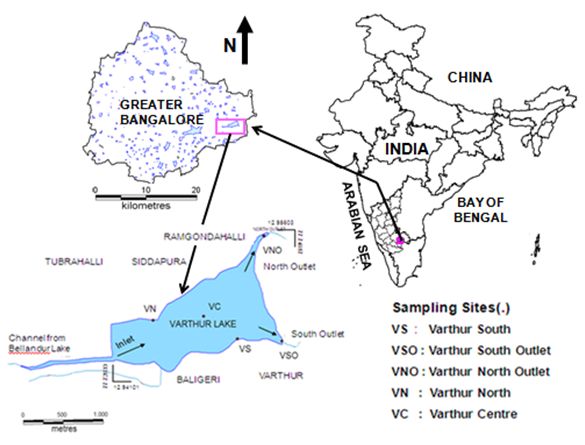1 Centre for Sustainable Technologies,
2 Centre for infrastructure, Sustainable Transportation and Urban Planning,
3 Energy and Wetlands Research Group, Centre for Ecological Sciences, Indian Institute of Science, Bangalore 560 012, India Materials and Methods Study area: Varthur Lake (12°57’24.98”-12°56’31.24”N, 77°43’03.02-77°44’51.1”E, Figure 1), is the second largest fresh water body in Bangalore with a water spread area of 220ha (mean depth 1.1m). Figure 2 exemplifies the coverage of macrophytes in Varthur lake in March and December. False colour composite (FCC) was generated using geo-referenced LANDSAT data (of 30m spatial resolution) for December and LISS III-IRS data (of 23m) for March. Macrophyte cover was very less during November–December and cover about 70-80% of water spread area during summer (Figure 2). During rainy periods, fresh water enters the lake as runoff, which also coincides with the phenological cycle of macrophytes.
Sampling and analysis: Water samples were collected every month during July08-June09 from five sampling sites-inlet, outlets and midpoints as shown in Figure 1 to examine the influent and the effluent water quality. Onsite measurements comprise estimation of pH, water and ambient temperature TDS, conductivity, dissolved oxygen and transparency. The samples were then carried to the lab and analyzed for the various organic and inorganic parameters. All the parameters were analyzed according to Standard Methods, APHA 1998. Water samples were also collected from the inlet stream and outlet stream of water passing through the wetland and were analyzed similarly. In addition, sludge samples collected at various locations from inlet to outlet were examined for the total organic carbon (TOC), total nitrogen content, available phosphorous and settling characteristics according to Standard methods. Citation: Durga Madhab Mahapatra, Chanakya H. N and T. V. Ramachandra, 2010, Sustainability and treatment potentials of an urban sewage-fed lake in Bangalore, India. Proceedings of the 17th National Symposium on Advances in Environmental Monitoring and Modeling, May 13-15, 2010, IIT Kanpur, Uttar Pradesh.
|
||||||||||||||||



